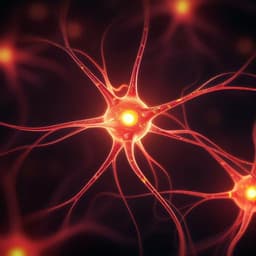
Biology
High-resolution landscape of an antibiotic binding site
K. B. Yang, M. Cameranesi, et al.
This groundbreaking research by Kevin B. Yang and colleagues reveals a collection of 760 single-residue mutants in *Escherichia coli* RNA polymerase, significantly influencing rifampicin binding and converting bacteriostatic effects to lethal action. The study uncovers mutations that enhance RNAP speed and examines natural sequence diversity, paving the way for novel antibiotic insights.
Playback language: English
Introduction
Antibiotic resistance is a major global health concern. Understanding the mechanisms of resistance is crucial for developing new strategies to combat it. Antibiotic binding sites, located within essential enzyme domains, are primary targets for resistance mutations. However, studying these sites is often hindered by the strong selective pressure favoring resistant mutants, making it difficult to observe the full spectrum of possible mutations and their effects. This paper focuses on the rifampicin binding site of *E. coli* RNA polymerase (RNAP), a well-studied system where resistance mutations are common. While high-resolution structures and studies of resistance mutants have provided valuable insights, they only represent a small fraction of the potential mutational space. The researchers aimed to overcome this limitation by employing multiplex automated genome engineering (MAGE) to create a comprehensive library of single-residue mutations within the rifampicin binding site, allowing for a high-resolution analysis of the functional landscape of this crucial region. This approach allowed them to explore not only resistance but also other phenotypic effects stemming from altered RNAP properties. The study's importance stems from the potential to uncover novel insights into both antibiotic resistance mechanisms and the fundamental biology of bacterial transcription.
Literature Review
Previous research on rifampicin resistance has mainly focused on mutations identified through selection for resistant phenotypes. These studies have provided valuable structural and functional information on the rifampicin binding site within the β-subunit of RNAP, showing that high-affinity binding prevents RNA chain extension beyond three nucleotides. However, these studies have only explored a small portion of the possible mutations in this region. High-resolution structures have confirmed earlier genetic findings, illustrating the interaction between rifampicin and RNAP. Resistance mutants, while instrumental in understanding the binding site, often display pleiotropic effects, reflecting alterations in RNAP function during different stages of the transcription cycle. The limitations of classical selection-based approaches in capturing the full functional landscape of the binding site motivated this study to utilize MAGE, a powerful tool that overcomes limitations of positive selection and low mutation rates. MAGE, coupled with sequencing, enables efficient and specific introduction and monitoring of mutations, providing a powerful means to explore a comprehensive mutational space.
Methodology
The researchers employed multiplex automated genome engineering (MAGE) to generate a saturated library of single amino acid substitutions within the rifampicin binding site of *E. coli* RNAP. This targeted region included positions 510-537 and 563-572 of the *rpoB* gene, known to interact with rifampicin. MAGE oligonucleotides were designed to introduce all 20 possible amino acid substitutions at each of the 38 positions, resulting in a total of 760 unique mutants. The generated mutant pool was then subjected to fitness screening and drug sensitivity assays using rifampicin, bicyclomycin (BCM), and 5-fluorouracil (5FU). Fitness was assessed by monitoring mutant abundance in regular growth conditions, while drug sensitivity was evaluated by comparing mutant abundances in the presence and absence of each drug. Data normalization was crucial to isolate drug-specific effects. The efficiency of MAGE was verified by sequencing libraries, and the majority of the expected substitutions were retrieved. To distinguish between drug-sensitive and inviable mutants, fitness was monitored under different growth conditions (liquid culture and agar plates). The distribution of fitness effects was analyzed, revealing a bimodal distribution similar to previous studies in essential proteins. Subsequently, drug sensitivity assays were conducted with rifampicin, BCM, and 5FU, using the normalization of drug to fitness data to identify drug-specific effects. The average fitness and drug resistance/sensitivity for each position were calculated to assess the mutability and functional importance of each amino acid residue. Rifampicin hypersensitive (RifHS) mutants were further characterized using various techniques, including recombinant protein expression, runoff transcription assays, chromatin immunoprecipitation sequencing (ChIP-seq), and viability assays to assess bactericidal effects. TUNEL assays were used to measure DNA fragmentation, while gene expression analysis (including SOS response genes) and LexA protein levels were examined. To determine the role of replication in Rif-induced DNA damage, knockout strains of DSB repair enzymes (*recA* and *recBCD*) and replication-blocking approaches (dCas9 targeting oriC and temperature-sensitive *dnaC* mutant) were utilized. Semi-long-range qPCR (SLR-qPCR) was employed to identify the location of DNA breaks. Finally, to explore the occurrence of natural variants, the researchers analyzed approximately 4000 *rpoB* orthologues from KEGG, assessing evolutionary conservation and the frequency of natural mutations within the rifampicin binding site. This allowed them to compare the functional effects of these natural mutations with those observed in the engineered mutants.
Key Findings
This study revealed a surprisingly mutable rifampicin binding site in *E. coli* RNAP, extending the known spectrum of resistance mutations. A critical alpha helix (positions 521-526) was identified where mutations either increased or decreased rifampicin potency. Specific single-residue mutations (e.g., L521Y and T525D) converted rifampicin from a bacteriostatic to a bactericidal drug. The bactericidal effect was linked to increased rifampicin binding affinity and the induction of replication-dependent DNA double-strand breaks (DSBs) at promoters, suggesting transcription-replication conflicts as the underlying mechanism. The study also found that mutations at other positions could lead to faster RNAP, with implications for nucleotide depletion, increased sensitivity to antibiotics (e.g., 5FU and trimethoprim), and a cold growth advantage. These fast RNAP mutants showed decreased pyrimidine nucleotide pools, supporting the hypothesis of nucleotide depletion as a key mechanism of 5FU sensitivity. Thymidine supplementation partially rescued the 5FU sensitivity, underlining the link between transcription speed and nucleotide availability. Analysis of natural *rpoB* sequence diversity showed frequent occurrences of functional mutations that confer either resistance or altered RNAP properties, highlighting the evolutionary significance of variations within this region. Specific examples include mutations at positions 24L (fast RNAP, increased frequency in Actinobacteria and Firmicutes), 26N (fast RNAP, high-level Rif resistance, found in Tenericutes), and 67Q (resistance to BCM and 5FU, found in Epsilonproteobacteria and Aquificae).
Discussion
The findings significantly advance our understanding of the rifampicin binding site, demonstrating its multifunctional nature beyond just mediating drug resistance. The conversion of rifampicin to a bactericidal agent through single amino acid substitutions in RNAP is a major discovery, potentially informing the design of more potent antibiotics or combination therapies. The mechanistic insight into rifampicin-induced DNA damage through transcription-replication conflicts suggests new therapeutic strategies. The demonstration that transcription speed affects nucleotide pools and antibiotic susceptibility opens up new avenues for research into bacterial physiology and its interactions with antimicrobial agents. The high frequency of functional mutations observed in natural populations reveals the evolutionary adaptability of the rifampicin binding site, with implications for predicting and managing antibiotic resistance. Further studies are needed to validate these findings in other bacterial species and to explore the full consequences of these mutations on bacterial physiology.
Conclusion
This study provides a comprehensive, high-resolution map of the functional landscape of the rifampicin binding site in *E. coli* RNAP. Key findings include the identification of mutations converting rifampicin to a bactericidal drug via transcription-replication conflicts and the demonstration of the impact of RNAP speed on nucleotide pools and antibiotic susceptibility. The discovery of frequent functional mutations in nature highlights the evolutionary plasticity of this crucial region. Future research could focus on validating these findings in other bacterial species and exploring therapeutic implications, such as developing more effective rifampicin analogues or combination therapies that exploit these newly discovered mechanisms.
Limitations
This study primarily focused on *E. coli*, and the generalizability of these findings to other bacterial species requires further investigation. The use of MAGE introduces a potential bias towards mutations that are compatible with at least minimal growth, thereby potentially excluding highly deleterious mutations. The analysis of natural sequence diversity relied on available genomic data, which might not represent the full spectrum of bacterial diversity. Furthermore, although the researchers identified a number of natural mutations and examined their phenotypic consequences, there is a need for further research to explore the evolutionary trajectories and ecological context of these mutations.
Related Publications
Explore these studies to deepen your understanding of the subject.







